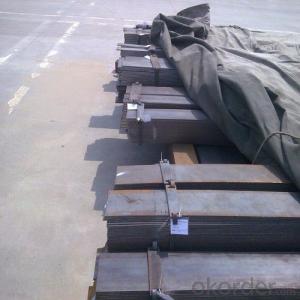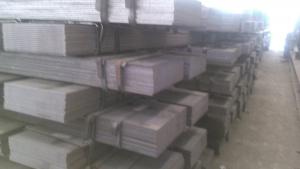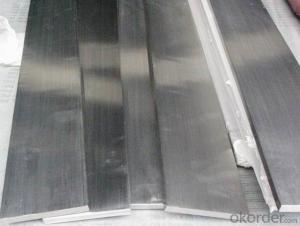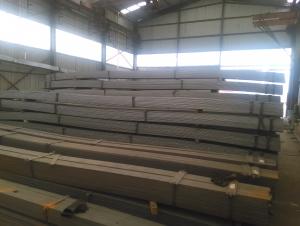High Quality Steel Flat Bar with Grade Q235
- Loading Port:
- Tianjin
- Payment Terms:
- TT OR LC
- Min Order Qty:
- 25 m.t.
- Supply Capability:
- 100000 m.t./month
OKorder Service Pledge
OKorder Financial Service
You Might Also Like
Specification of Steel Flat Bar
Commodity: Carbon Steel Flat Bar
Standard: GB,JIS,ASTM,
Material: Q235,SS400 or Equivalent
Brand name: FLATSPACE
Origin place: China
Thickness: 3mm-30mm
Width:20mm-200mm
Length: Max 12m
Certification: SGS/BV
Chemical composition of Q235
Alloy No | Grade | Element(%) | ||||
C
| Mn
| S
| P
| Si
| ||
Q235
|
B
|
0.12—0.20 |
0.3—0.7 |
≤0.045 |
≤0.045
|
≤0.3
|
Physical properties of Q235
Alloy No | Grade | Yielding strength point(Mpa) | Tensile strength (Mpa) | Elongation after fracture(%) | ||||||
Thickness (mm) | Thickness (mm) | |||||||||
≤16 | >16--40 | >40--60 | >60--100 | ≤16 | >16--40 | >40--60 | >60--100 | |||
≥ | ≥ | |||||||||
Q235 |
B |
235 |
225 |
215 |
205 |
375--500 |
26 |
25 |
24 |
23 |
Above sheets show the technical data of Q235,we can also provide other materials similar to Q235.
Usage/Applications of Steel Flat Bar
Widely used for construction;
Machinery manufacturing;
Iron tower steel structure;
Shipbuilding; Steel grating;
Staircase;
Bridge;
Viaduct;
Railway spare parts;
Boilers making etc.
Packaging & Delivery of Steel Flat Bar
Packaging Details: The Steel Flat Bars are packed in bundles and loaded in 20 feet/40 feet container, or shipped by bulk cargo ,also we can do as customer's requirements.
Delivery Details:30~45 days upon the receipt of buyer payment by T.T. or L/C.
- Q:Are steel flat bars suitable for handrail applications?
- Yes, steel flat bars are suitable for handrail applications. They are strong, durable, and can be easily shaped and welded to meet the specific requirements of handrails. Additionally, steel flat bars offer a sleek and modern aesthetic, making them a popular choice for handrail designs.
- Q:Can steel flat bars be used for making mining industry equipment?
- Steel flat bars are an excellent choice for the fabrication of mining industry equipment. Being a durable and strong material, steel can withstand the challenging conditions and heavy loads typically encountered in mining. These bars can be utilized in the construction of various mining equipment including conveyor systems, support structures, frames, and components for mining machinery. With their flat shape, they are easy to cut, shape, and weld, making them highly versatile for manufacturing mining equipment. Furthermore, steel flat bars are readily available in different grades and thicknesses, ensuring they can meet the specific requirements of any mining operation. In conclusion, steel flat bars offer a reliable and cost-effective solution for producing mining industry equipment.
- Q:Are steel flat bars commonly used in the furniture industry?
- Steel flat bars are widely utilized in the furniture industry due to their versatility and durability, which renders them an excellent option for constructing diverse furniture pieces. Commonly employed as structural supports or legs for tables, chairs, and other furniture items, these bars offer stability and strength, ensuring the furniture's ability to endure weight and frequent use. Moreover, furniture manufacturers and designers favor steel flat bars due to their ease of welding, drilling, and shaping to meet specific design specifications.
- Q:Are steel flat bars available in different surface coatings?
- Different surface coatings are available for steel flat bars, which serve to enhance durability, corrosion resistance, and aesthetic appearance. Galvanizing is a common coating method involving the application of a layer of zinc to protect against rust and corrosion. Another popular option is powder coating, wherein a dry powder is electrostatically applied and then cured under heat to form a tough and long-lasting finish. Additionally, epoxy or enamel paints can be used to coat steel flat bars, providing added protection and the desired color. The selection of a surface coating depends on the particular application and the desired properties of the steel flat bars.
- Q:Are steel flat bars suitable for load-bearing applications?
- Yes, steel flat bars are suitable for load-bearing applications. They are commonly used in construction and engineering projects where strength and durability are required to support heavy loads. The flat shape of the bar provides stability and resistance to bending or warping under pressure, making it an ideal choice for load-bearing purposes.
- Q:Can steel flat bars be used for manufacturing machinery?
- Certainly! Steel flat bars find extensive use in the manufacturing of machinery. They are highly adaptable and widely employed in various industries, including machinery production. These bars possess the qualities of strength, durability, and stability, rendering them ideal for the construction of machine frames, supports, brackets, and other vital components. Moreover, manufacturers can choose from a wide range of grades and sizes of steel flat bars to suit the specific requirements of the machinery being fabricated. In addition, these bars can be effortlessly machined and welded, allowing manufacturers to seamlessly customize and assemble machinery. On the whole, steel flat bars are a dependable choice for machinery manufacturing due to their mechanical properties and versatility.
- Q:What is the difference between hot-rolled and cold-drawn steel flat bars?
- Hot-rolled and cold-drawn steel flat bars find extensive usage across multiple industries, but they possess distinct dissimilarities. Hot-rolled steel flat bars are manufactured by subjecting a steel billet or slab to high temperatures and subsequently rolling it into the desired shape, such as a rectangle or square. This process enables quick and efficient production of larger sizes and quantities. The resulting hot-rolled steel bars possess a rougher surface and may contain mill scale or a slight oxide layer due to the elevated temperatures involved in the manufacturing process. Conversely, cold-drawn steel flat bars are formed by pulling a hot-rolled steel bar through a die at room temperature. This technique aids in enhancing the dimensional accuracy, surface finish, and mechanical properties of the steel. Cold-drawn steel bars exhibit a smoother surface and tighter tolerances compared to their hot-rolled counterparts. Additionally, they possess higher yield strength and tensile strength, making them suitable for applications requiring increased strength and precision. Due to their divergent manufacturing processes, hot-rolled steel flat bars are generally more cost-effective and easily obtainable in larger sizes and quantities. They are commonly employed in construction, manufacturing, and general fabrication applications, where surface finish and tight tolerances are of lesser importance. In contrast, cold-drawn steel flat bars are favored for applications necessitating higher precision, tighter tolerances, and improved mechanical properties. They are frequently utilized in industries such as automotive, aerospace, and machinery manufacturing, where strength, dimensional accuracy, and surface finish are critical factors. In conclusion, the primary disparities between hot-rolled and cold-drawn steel flat bars reside in their manufacturing processes and resultant properties. Hot-rolled bars offer cost-effectiveness and availability in larger sizes, whereas cold-drawn bars provide enhanced precision, tighter tolerances, and improved mechanical properties. The selection between the two depends on the specific requirements of the application and the desired balance of cost, strength, and surface finish.
- Q:Can steel flat bars be used in construction projects?
- Yes, steel flat bars can be used in construction projects. Steel flat bars are versatile and widely used in various construction applications due to their strength and durability. They are commonly used in the construction of buildings, bridges, highways, and other infrastructure projects. Steel flat bars are often used as structural support elements, such as in beams, columns, and braces, due to their ability to bear heavy loads and resist bending. They can also be used as reinforcement in concrete structures, such as slabs and foundations, to enhance the overall strength and stability of the construction. Additionally, steel flat bars can be easily welded, bent, and fabricated to meet specific project requirements, making them a popular choice in construction.
- Q:Can steel flat bars be used for making renewable energy industry equipment?
- Yes, steel flat bars can be used for making renewable energy industry equipment. Steel is a versatile and durable material that is commonly used in the construction of various renewable energy equipment such as solar panel frames, wind turbine structures, and support systems. Its strength and corrosion resistance make it an ideal choice for handling the demanding conditions in the renewable energy industry. Additionally, steel can be easily recycled, aligning with the sustainability goals of the renewable energy sector.
- Q:Can steel flat bars be used for making brackets or supports for plumbing systems?
- Indeed, brackets or supports for plumbing systems can be made using steel flat bars. Within construction and plumbing, steel is widely utilized due to its robustness and longevity. Opting for steel flat bars offers a dependable and strong solution, capable of effectively supporting the weight of plumbing pipes and fixtures. Furthermore, steel exhibits resistance against corrosion, rendering it appropriate for deployment in damp settings like plumbing systems. All things considered, steel flat bars serve as a fitting selection for fabricating brackets or supports for plumbing systems.
1. Manufacturer Overview |
|
|---|---|
| Location | |
| Year Established | |
| Annual Output Value | |
| Main Markets | |
| Company Certifications | |
2. Manufacturer Certificates |
|
|---|---|
| a) Certification Name | |
| Range | |
| Reference | |
| Validity Period | |
3. Manufacturer Capability |
|
|---|---|
| a)Trade Capacity | |
| Nearest Port | |
| Export Percentage | |
| No.of Employees in Trade Department | |
| Language Spoken: | |
| b)Factory Information | |
| Factory Size: | |
| No. of Production Lines | |
| Contract Manufacturing | |
| Product Price Range | |
Send your message to us
High Quality Steel Flat Bar with Grade Q235
- Loading Port:
- Tianjin
- Payment Terms:
- TT OR LC
- Min Order Qty:
- 25 m.t.
- Supply Capability:
- 100000 m.t./month
OKorder Service Pledge
OKorder Financial Service
Similar products
New products
Hot products
Related keywords




























